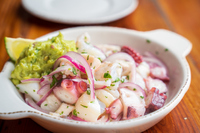
Ceviche - Its Easy
Ceviche — It’s Easy (Safe, Bright, 20 Minutes)
Ceviche — It’s Easy (Safe, Bright, 20 Minutes)
Firm white fish, fresh lime, crisp veg. Short marinade = silky texture. This version is Med-Diet friendly and spotlights technique + safety so your bowl is bright, clean, and delicious.
Time: ~20 min Yield: 4 servings No stove
Ingredients
- 1 lb white fish (halibut, rockfish, snapper, sea bass, cod), previously frozen*
- 3/4–1 cup lime juice (fresh) + optional 2 Tbsp lemon
- 1/2 small red onion, thinly sliced, rinsed
- 1–2 jalapeños, minced (or 1 serrano)
- 1 small cucumber, seeded & diced
- Optional: 1 cup tomato, diced; 1 avocado, diced; 2 Tbsp olive oil
- Salt: ~1 tsp kosher (Diamond) to taste; less if Morton
- Cilantro: 1/2 cup, chopped; lime wedges to serve
*Safety: Use fish labeled “previously frozen,” “sushi-grade,” or freeze your fish before marinating (see safety notes below).
Method
- Cube & salt: Cut fish into 1/2″ cubes. Toss with half the salt; chill 5 minutes.
- Marinate: Cover with citrus. Chill 15–20 minutes, stirring once, until edges turn opaque; centers should remain just tender.
- Drain & season: Drain most citrus (leave a few tablespoons). Fold in onion, jalapeño, cucumber, tomato (optional), cilantro, remaining salt, and olive oil (optional).
- Finish: Fold in avocado (optional). Taste and adjust with more salt or lime. Serve immediately.
Going longer than ~30–45 minutes in acid can firm the fish too much and taste “overcooked.”
Marinade Timing Guide
| Cut size | Fish type | Time (fridge) | Doneness cue |
|---|---|---|---|
| 1/2″ cubes | Firm white (halibut/rockfish/snapper) | 15–20 min | Edges opaque, centers tender |
| 3/4″ cubes | Firm white | 25–35 min | Mostly opaque, still juicy |
| Thin slices | Very firm (sea bass/cod) | 10–15 min | Slices opaque, pliable |
| 1/2″ cubes | Salmon/tuna* | 20–30 min | Edges opaque, centers rosy |
*Salmon/tuna: use only sashimi-grade/previously frozen fish; wild salmon is more prone to parasites.
Food Safety (Read This!)
- Citrus does not “cook” for safety. Acid changes texture/color but does not reliably kill parasites or bacteria.
- Use previously frozen fish from a reputable source, labeled for raw consumption, or freeze your fish before marinating (home standard: at or below −4°F / −20°C for 7 days; commercial deep-freeze standards may be shorter).
- Keep it cold (≤40°F / 4°C) and eat the same day.
- Shellfish version: For shrimp, many cooks briefly blanch (30–60 sec) then chill before marinating for texture and safety.
Mediterranean Diet Points
- Seafood: ~4 oz cooked fish = 1 point (this recipe is designed around that per serving).
- Vegetables: onion, jalapeño, cucumber, tomato nudge your daily veg tally.
- Healthy fats: a light olive-oil finish supports the unsaturated > saturated goal.
- Whole grains (optional): serve with whole-grain tostadas or 1/2 cup brown rice for the grain point.
Nutrition (estimates)
Per serving (1/4 recipe), using lean white fish and no avocado; brands & portions vary.
| Version | Calories | Protein | Carbs | Fat | Fiber | Sodium* |
|---|---|---|---|---|---|---|
| Base (no oil) | ~160 | ~24–26 g | ~5–6 g | ~2 g | ~1–2 g | varies |
| + olive-oil finish | ~200 | ~24–26 g | ~5–6 g | ~9 g | ~1–2 g | varies |
| + 1/4 avocado | ~235 | ~24–26 g | ~7 g | ~13 g | ~4 g | varies |
*Mainly from added salt. Rinse onions and keep citrus fresh to avoid oversalting.
Variations
- Mango-Avocado: Fold in 1/2 cup diced mango and 1/2 diced avocado; add a pinch of chili and extra lime.
- Shrimp Ceviche: Use small cooked shrimp (or briefly blanch raw), then marinate 10–15 min with the veg.
- Scallop Ceviche: Use previously frozen dry-pack scallops; slice thin and marinate 10–12 min.
- Tomato-free (Peruvian-lean): Skip tomato; add a little fish stock or “leche de tigre” for punch.
